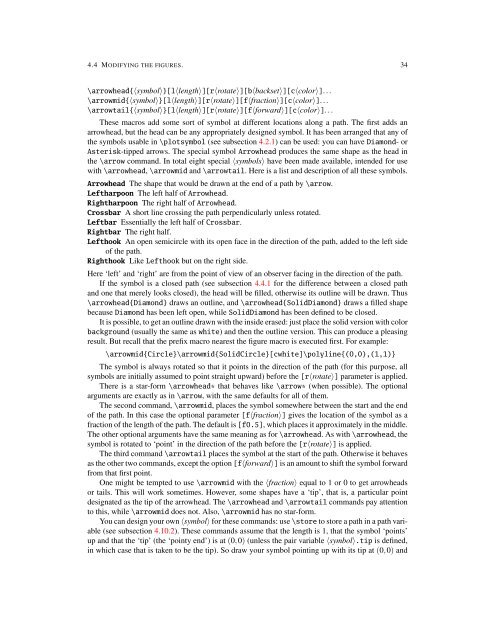Create successful ePaper yourself
Turn your PDF publications into a flip-book with our unique Google optimized e-Paper software.
4.4 MODIFYING THE FIGURES. 34<br />
\arrowhead{〈symbol〉}[l〈length〉][r〈rotate〉][b〈backset〉][c〈color〉]...<br />
\arrowmid{〈symbol〉}[l〈length〉][r〈rotate〉][f〈fraction〉][c〈color〉]...<br />
\arrowtail{〈symbol〉}[l〈length〉][r〈rotate〉][f〈forward〉][c〈color〉]...<br />
These macros add some sort of symbol at different locations along a path. The first adds an<br />
arrowhead, but the head can be any appropriately designed symbol. It has been arranged that any of<br />
the symbols usable in \plotsymbol (see subsection 4.2.1) can be used: you can have Diamond- or<br />
Asterisk-tipped arrows. The special symbol Arrowhead produces the same shape as the head in<br />
the \arrow command. In total eight special 〈symbols〉 have been made available, intended for use<br />
with \arrowhead, \arrowmid and \arrowtail. Here is a list and description of all these symbols.<br />
Arrowhead The shape that would be drawn at the end of a path by \arrow.<br />
Leftharpoon The left half of Arrowhead.<br />
Rightharpoon The right half of Arrowhead.<br />
Crossbar A short line crossing the path perpendicularly unless rotated.<br />
Leftbar Essentially the left half of Crossbar.<br />
Rightbar The right half.<br />
Lefthook An open semicircle with its open face in the direction of the path, added to the left side<br />
of the path.<br />
Righthook Like Lefthook but on the right side.<br />
Here ‘left’ and ‘right’ are from the point of view of an observer facing in the direction of the path.<br />
If the symbol is a closed path (see subsection 4.4.1 for the difference between a closed path<br />
and one that merely looks closed), the head will be filled, otherwise its outline will be drawn. Thus<br />
\arrowhead{Diamond} draws an outline, and \arrowhead{SolidDiamond} draws a filled shape<br />
because Diamond has been left open, while SolidDiamond has been defined to be closed.<br />
It is possible, to get an outline drawn with the inside erased: just place the solid version with color<br />
background (usually the same as white) and then the outline version. This can produce a pleasing<br />
result. But recall that the prefix macro nearest the figure macro is executed first. For example:<br />
\arrowmid{Circle}\arrowmid{SolidCircle}[cwhite]\polyline{(0,0),(1,1)}<br />
The symbol is always rotated so that it points in the direction of the path (for this purpose, all<br />
symbols are initially assumed to point straight upward) before the [r〈rotate〉] parameter is applied.<br />
There is a star-form \arrowhead* that behaves like \arrow* (when possible). The optional<br />
arguments are exactly as in \arrow, with the same defaults for all of them.<br />
The second command, \arrowmid, places the symbol somewhere between the start and the end<br />
of the path. In this case the optional parameter [f〈fraction〉] gives the location of the symbol as a<br />
fraction of the length of the path. The default is [f0.5], which places it approximately in the middle.<br />
The other optional arguments have the same meaning as for \arrowhead. As with \arrowhead, the<br />
symbol is rotated to ‘point’ in the direction of the path before the [r〈rotate〉] is applied.<br />
The third command \arrowtail places the symbol at the start of the path. Otherwise it behaves<br />
as the other two commands, except the option [f〈forward〉] is an amount to shift the symbol forward<br />
from that first point.<br />
One might be tempted to use \arrowmid with the 〈fraction〉 equal to 1 or 0 to get arrowheads<br />
or tails. This will work sometimes. However, some shapes have a ‘tip’, that is, a particular point<br />
designated as the tip of the arrowhead. The \arrowhead and \arrowtail commands pay attention<br />
to this, while \arrowmid does not. Also, \arrowmid has no star-form.<br />
You can design your own 〈symbol〉 for these commands: use \store to store a path in a path variable<br />
(see subsection 4.10.2). These commands assume that the length is 1, that the symbol ‘points’<br />
up and that the ‘tip’ (the ‘pointy end’) is at (0,0) (unless the pair variable 〈symbol〉.tip is defined,<br />
in which case that is taken to be the tip). So draw your symbol pointing up with its tip at (0,0) and

















